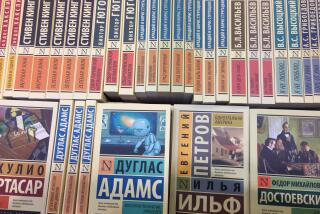Reagan Portrays ‘Open World,’ With ‘Sesame Street’ for Soviets
- Share via
WASHINGTON — President Reagan painted an appealing picture Thursday night of an “open world” where American and Russian students attend each other’s schools, superpower competition is transferred to athletic fields and Soviet children watch “Sesame Street.”
“Imagine how much good we could accomplish, how the cause of peace would be served, if more individuals and families from our respective countries could come to know each other in a personal way,” Reagan said.
But if history is any guide, cultural and scientific exchanges tend to reflect--rather than establish--the tone of relations between Washington and Moscow. And there is not much reason to believe that tensions will be eased enough during the Reagan-Gorbachev summit to permit massive people-to-people exchanges.
Cultural exchange programs began in 1957 in the warm afterglow of the 1955 U.S.-Soviet-British-French summit that spawned what came to be called “the spirit of Geneva.” The programs hit their peak in the early 1970s, at the height of the short-lived U.S.-Soviet detente. And they ended abruptly in 1979, after the Soviet invasion of Afghanistan.
Signing of Cultural Pact
Administration officials say that Reagan expects to join Gorbachev next week in signing a pact, recently drafted by U.S. and Soviet negotiators, to resume cultural and scientific exchanges. But the agreement was said to be a modest one, falling far short of the massive interchange that Reagan talked about in his speech.
Some exchanges the President proposed are almost certain to be included in the new agreement. For instance, when he said, “Imagine if people in our nation could see the Bolshoi Ballet again, while Soviet citizens could see American plays and hear groups like the Beach Boys,” he was outlining exactly the sort of exchanges that took place between 1957 and 1979.
But when he went on to suggest “the exchange of thousands of (college) undergraduates each year, and even younger students who would live with a host family and attend schools and summer camps,” he was going far beyond anything the Soviets have ever been willing to accept.
In the past, the Soviets have played host to many American students, although not in the numbers Reagan seemed to suggest. But most Soviet “students” who were sent to the United States were in their 30s and were clearly selected for their political reliability.
In negotiations earlier this year, the Soviets insisted on U.S. promises to prevent defections of Soviet artists who visit the United States on cultural exchange programs. Administration officials say Washington rejected that demand, but it is clear that the Soviets do not want to risk massive defections. The Soviet determination to regain custody of a sailor who recently jumped ship near New Orleans indicates Moscow’s attitude on that matter.
Reagan did not make his proposal more attractive to Moscow when he said: “If Soviet youth could attend American schools and universities, they could learn first-hand what spirit of freedom rules our land.”
More to Read
Sign up for Essential California
The most important California stories and recommendations in your inbox every morning.
You may occasionally receive promotional content from the Los Angeles Times.













